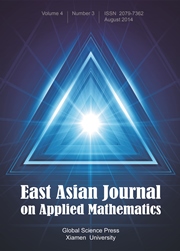No CrossRef data available.
Article contents
Correlation Between Mesh Geometry and Stiffness Matrix Conditioning for Nonlocal Diffusion Models
Published online by Cambridge University Press: 16 July 2018
Abstract
Nonlocal diffusion models involve integral equations that account for nonlocal interactions and do not explicitly employ differential operators in the space variables. Due to the nonlocality they might look different from classical partial differential equation (PDE) models, but their local limit reduces to partial differential equations. The effect of mesh element anisotropy mesh refinement and kernel functions on the conditioning of the stiffness matrix for a nonlocal diffusion model on 2D geometric domains is considered, and the results compared with those obtained from typical local PDE models. Numerical experiments show that the condition number is bounded by  (where c is a constant) for an integrable kernel function, and is not affected by the choice of the basis function. In contrast to local PDE models, mesh anisotropy and refinement affect the condition number very little.
(where c is a constant) for an integrable kernel function, and is not affected by the choice of the basis function. In contrast to local PDE models, mesh anisotropy and refinement affect the condition number very little.
- Type
- Research Article
- Information
- Copyright
- Copyright © Global-Science Press 2014


